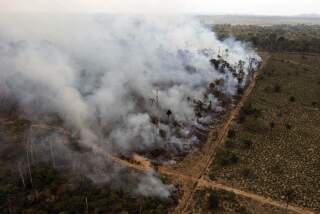Editorial: California may be leading on climate change, but that doesn’t mean it can ignore local pollution
Last year California lawmakers doubled down on the state’s landmark law to cut greenhouse gas emissions. The passage of Senate Bill 32 obligated the state to reduce emissions 40% below the 1990 level by 2030. It is an ambitious target that has, again, made California one of the world leaders in fighting climate change.
This year lawmakers are haggling over the details: Specifically, how will California meet the new, more aggressive timeline?
Gov. Jerry Brown has been pushing them to extend the state’s existing “cap-and-trade” program for carbon emissions, which could otherwise expire in 2020. State leaders picked cap and trade over other options, such as imposing a carbon tax on emitters, because they wanted a market-based system that would incentivize companies to cut emissions while also giving them flexibility as to how they meet the state mandate.
Under cap and trade, companies can install pollution-cutting equipment in their facilities to meet carbon emissions limits, or they can buy permits to exceed them. (The state auctions off a limited number of permits, and others are available from companies that cut their emissions more than required.) They can also offset their excess emissions by paying for greenhouse gas reductions elsewhere in the U.S. — for example, by preserving a forest in Michigan. Because climate change is a global problem, it doesn’t matter where you cut emissions so long as you reduce greenhouse gases in the atmosphere.
California can continue its world leadership on climate change, but state leaders can’t leave suffering communities behind.
It’s often significantly cheaper for companies to buy permits or pay for projects outside California than to install pollution-cutting equipment, which is why industry groups are lobbying hard to preserve the cap and trade program. Some lawmakers and environmental groups also like cap and trade because it helps keep down the costs of compliance, meaning fewer price increases for consumers and less risk of companies and jobs fleeing to other states. That’s important because too few states have followed California’s leadership on climate change.
But some other environmental groups and lawmakers want to end cap-and-trade, or at least significantly overhaul it so that companies have to cut their greenhouse gas emissions in California. Their eyes are on a different prize: When a refinery or power plant installs equipment to cut greenhouse gases, it also reduces smog, soot and toxic air contaminants that have a very real local impact on public health.
Because major emitters in California have the flexibility under cap and trade to buy carbon reductions, they can often avoid upgrading their own facilities. Researchers from UC Berkeley and the University of Southern California released a study last year that found in-state greenhouse gas emissions increased on average for several industry sectors regulated under the cap-and-trade program. And the highest-emitting facilities are more likely to be located in low-income and minority communities. So even though California’s law is bringing down overall greenhouse gas emissions around the world, it may nevertheless be allowing for increased pollution here in the state.
Assemblywoman Cristina Garcia (D-Bell Gardens) offered a bill this session that would have, for the first time, required facilities to clean up their smog, soot and toxic pollution before they could get some of the perks and flexibility of the cap-and-trade program. Her bill died amid heavy lobbying from the oil industry, but she and a coalition of Democratic lawmakers have demanded that the cap and trade extension deal also address local air pollution. They’re right.
Brown and the California Air Resources Board have been so focused on leading the world on climate change that they’ve neglected pollution in their own backyard. Communities like those represented by Garcia still live with unhealthful levels of pollution from industrial sites, diesel trucks and trains.
To his credit, the governor appears to get it. He toured the polluted neighborhoods in Garcia’s district and listened to activists’ concerns that he had focused on climate change to the exclusion of local pollution problems. His top aide Nancy McFadden acknowledged that the state is not doing enough on air quality issues and said the governor would develop a separate plan to address the most polluted communities. That’s a start, but any plan should include real goals, deadlines and enforcement to make sure the state’s disadvantaged communities aren’t forgotten again in the fight against global climate change.
Ultimately, lawmakers should extend cap and trade with reforms to ensure it will deliver the needed emissions reductions going forward. So far the program has worked fairly well in its primary goal: to cut global greenhouse gases without slowing economic growth. It’s also worth remembering that cap and trade is just one piece of the state’s plan to meet the aggressive 2030 targets; others include requiring utilities to provide half of their electricity from renewable sources and mandating that public transit agencies buy zero-emissions buses.
California can continue its world leadership on climate change, but state leaders can’t leave suffering communities behind.
Follow the Opinion section on Twitter @latimesopinion and Facebook
More to Read
A cure for the common opinion
Get thought-provoking perspectives with our weekly newsletter.
You may occasionally receive promotional content from the Los Angeles Times.






